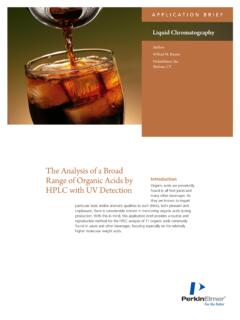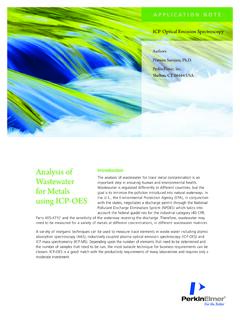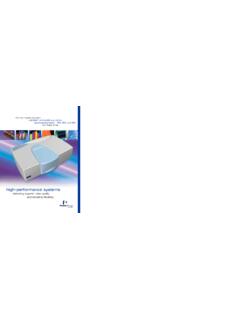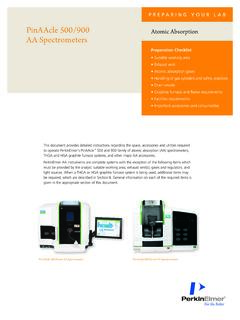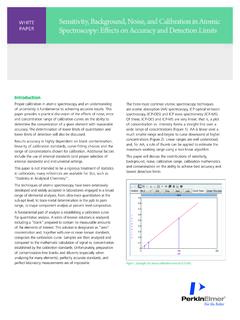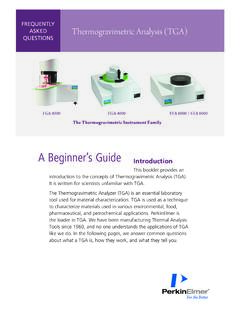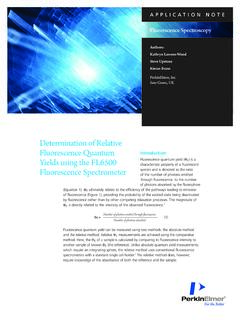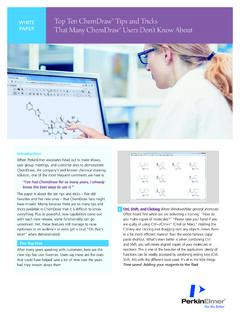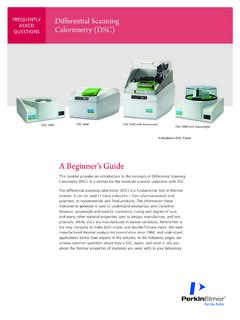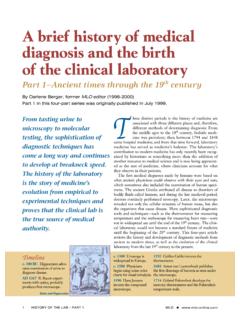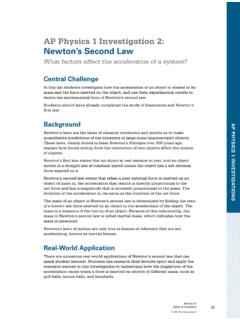Transcription of Validating UV/Visible Spectrophotometers
1 UV/Visible Spectrophotometers are widely used by many laboratories including those found in academia and research as well as industrial quality assurance. The technique is mainly used quantitatively (although some qualitative analysis can also be performed).For any type of critical determination, whether it be clinical, pharmaceutical or industrial QC, environmental analysis or research, it is essential that the instrument is performing according to specification. In some of these applications, it is important that the instrument performance is monitored regularly and that there is documentary evidence that this is the case. This will apply to any measurements to do with human or animal health (clinical or pharmaceutical/nutraceutical), food or labs offering an accredited measurement service ( in accordance with ISO 17025).
2 Validation is also a key requirement of Good Laboratory Practice (GLP).Testing frequencyOne common question from laboratories relates to the frequency of testing. There are no regulations, as such, regarding this but for any human health or nutrition related analysis , a testing frequency of at least monthly should be considered. If the instrument is in a high sample throughput environment, then some additional weekly testing ( absorbance and wavelength check) should be noTeUV/Vis SpectroscopyValidating UV/Visible SpectrophotometersAuthorSteve Upstone Principal UV/Vis/NIR Spectroscopy SpecialistPerkinElmer, Inc. Seer Green, UK2 Testing wavelength accuracyWavelength accuracy is normally assessed by using either a sample containing a series of very sharp peaks such as a solution of holmium perchlorate or a holmium oxide and/or didymium doped glass filter or by measuring the emission from a lamp.
3 If the instrument is equipped with a deuterium (D2) lamp as the UV source, this can be used. An external mercury (Hg) lamp can also be used. This is less convenient than using the previously mentioned methods but methodology exists ( in the Ph. Eur. tests) for its use as an alternative to a glass or liquid standard. The advantage of emission lines is that they are inviolate ( the emission wavelengths don t change over time).Using the deuterium lampIf the instrument uses a deuterium lamp, it is possible to measure the very sharp emission line at nm by switching off the visible lamp and measuring the energy (single beam mode). There is also a weaker emission line at nm that can be used. This is not as rigorous as using other wavelength standards (as fewer lines are available) but it does serve as a very convenient and accurate way to assess that the instrument s optics are aligned correctly.
4 Some PerkinElmer instruments (such as the LAMBDA 25/35/45) use the nm emission line of D2 upon switch-on to calibrate the monochromator. Others (such as the LAMBDA 800/900 and LAMBDA X50 series) can perform this calibration on demand (and store the values in the instrument firmware). UV WinLab v5 and v6 have methods to check this and produce a report). These methods use the rear beam for the procedure (just in case a sample has been left in the front position by mistake). The nm emission line (but not the nm line) is one of the possible test points in the Ph. Eur. (2005).Using a mercury emission sourceThe use of a mercury (Hg) emission lamp is another way to check wavelengths. This lamp offers more lines compared to deuterium particularly in the UV region.
5 The practicalities of using such a lamp are a little more difficult. The mercury lamp needs to be placed in the instrument s lamp compartment. The principal mercury emission lines are shown in Figure 1. Deuterium peak showing peak close to nm (smaller peak is due to the heavier tritium).Figure 4. Spectrum of holmium perchlorate solution for wavelength accuracy nm nm nm nm nm nm nm nm nmFigure 2. Wavelengths for mercury emission and liquid filtersThe most commonly used glass (or quartz) filter is holmium oxide. This provides a quick and easy way to check wave-length accuracy. This standard gives a series of lines in the visible region. It does not provide strong absorption peaks into the UV region and so a solution of holmium oxide in perchloric acid (holmium perchlorate) is recommended by some pharmacopoeias but for general non-pharmacopoeia instrument testing, holmium oxide glass is widely used.
6 Another material that is used is didymium a mixture of praseodymium and neodymium. This is recommended by the Pharmacopoeia (USP 24) as well as others such as the JP (Japanese Pharmacopoeia). As with holmium oxide, it is also available in solution form. Other wavelength standard solutions commercially available include samarium perchlorate, which gives a range of wavelengths in the UV and visible regions between 230 and 560 nm and rare earth sulphate which gives far UV wavelengths between 201 nm and 253 oxide quartz nm nm nm nm nmHolmium perchlorate solution nm nm nm nmDidymium glass nm nm nm nm nmFigure 3. Wavelengths for holmium oxide glass, holmium perchlorate solution and didymium as part of their determinations but it is very rare to find it used elsewhere due to its complexity and offering a precision that is unnecessary for most light testingStray light can be defined as the amount of unwanted wavelengths that are present in the sample beam.
7 In a conventional dispersive instrument, the monochromator is before the sample and the sample receives one wavelength at a time. After the sample, there is only the detector. This means that any stray light that gets past the monochromator will be seen by the detector. Stray light has a strong impact on the instrument s ability to record accurately at higher absorbances and is a key specification when assessing the quality of a spectrophotometer. For a single monochromator instrument (as found in most chemical and biochemical laboratories) the best achievable stray light value (using ASTM methodology) will be around This equates to one in every 10,000 photons being due to stray light. This may sound like a small amount but it has to be remembered that absorbance is a logarithmic scale and so 3AU (equivalent to ) equates to only one in a thousand photons actually passing through the sample and reaching the detector.
8 If the stray radiation is mainly far stray light ( wavelengths some distance from the actual analytical wavelength) then it is unlikely to be absorbed by the sample and thus will cause the linearity to become worse at higher absorbances as the absorbance becomes swamped by the [constant] stray light. If linear performance greater than 3A is required, systems with more than one monochromator must be considered either premonochromator (using a smaller auxiliary Photometric (absorbance) accuracy testingAs with wavelength accuracy testing, either solutions or glass/quartz filters can be used. For general applications neutral density grey glass filters (such as the NIST 930D set) are a convenient way to test the photometric accuracy of instruments.)
9 These offer a number of wavelengths in the visible region. For testing in the UV either metal on quartz glass filters or solutions must be used. Metal on quartz filters have a reflective coating applied to a quartz plate. This can cause issues due to the strong back reflection sent back through the instrument s optics so they may not be suitable for all types of instruments. The coating needs to be treated with care as any damage will alter the optical most commonly used solution for checking absorbance accuracy is potassium dichromate. The original 1988 Ph. Eur. method tests absorbance at four wavelengths 235, 257, 313 and 350 nm using between and mg of potassium dichromate in M sulphuric acid diluted to 1000 mL.
10 Since 2005 a second solution has been added to provide an additional test point at 430 nm. This uses the same amount of potassium dichromate but is made up to 100 mL ( it is ten times more concentrated than the original solution). In both cases the A 1%/1 cm value is recorded and checked against the target acid ( M hydrocholoric acid) in a range between 6 and 24 mg/L) can be used to assess photometric accuracy in the far UV region (at 213 nm and 261 nm). This is not an official procedure but reference materials are commercially available for this has to be taken when preparing the solutions as potassium dichromate is hygroscopic and so it is important that this is dried thoroughly otherwise the weight will be incorrect and this could result in an unnecessary aperture correction for photometric accuracyNo instrument has a perfectly linear detector response and so the observed photometric accuracy will have a greater deviance from the certified values as a result.
